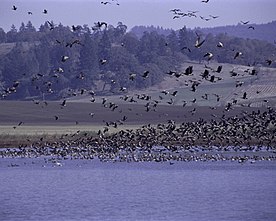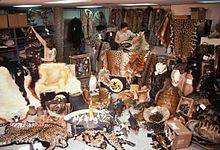 | |
| Founded | 1951 |
|---|---|
| Type | charitable environmental organization |
| Focus | environmental conservation |
| Headquarters | Arlington, Virginia, United States |
Area served
| Global |
| Method | Conservation by design |
Members
| More than 1 million |
Key people
|
|
Revenue
| US$1.29 billion (2018) |
| Website | www |
The Nature Conservancy (TNC) is a charitable environmental organization, headquartered in Arlington, Virginia, United States.
Founded in 1951, The Nature Conservancy has over one million
members, and has protected more
than 119,000,000 acres (48,000,000 ha)
of land and thousands of miles of rivers worldwide. The largest environmental nonprofit by assets and revenue in the Americas, The Nature Conservancy ranks as one of the most trusted national organizations in Harris Interactive polls every year since 2005. Forbes magazine rated The Nature Conservancy's fundraising efficiency at 88 percent in its 2005 survey of the largest U.S. charities. The Conservancy received a three-star rating from Charity Navigator in 2016 (three-star in 2015).
History
The Nature Conservancy at 2017 Capital Pride.
The Nature Conservancy developed out of a scholarly organization known as the Ecological Society of America (ESA).
The ESA was founded in 1915 and two years later formed a Committee on
Preservation of Natural Areas for Ecological Study, headed by Victor Shelford.
Whereas the Society primarily focused on promoting research, in the
course of the 1930s Shelford and his colleagues increasingly sought to
advocate for conservation.
The divide in viewpoints regarding scholarship or advocacy led the
Society to dissolve the committee, and, in 1946, Shelford and his
colleagues formed the Ecologists' Union.
The latter group eventually took the name "The Nature Conservancy", in
emulation of the British agency of that name, which pursued a mission of
conserving open space and wildlife preserves. The Nature Conservancy
was incorporated in the United States as a non-profit organization on
October 22, 1951.
Featured project sites
Nature Conservancy of Tennessee's William B. Clark, Sr., Nature Preserve on the Wolf River at Rossville, Tennessee
The Nature Conservancy's expanding international conservation efforts include work in North America, Central America, and South America, Africa, the Pacific Rim, the Caribbean, and Asia.
The Nature Conservancy and its conservation partner, Pronatura Peninsula Yucatán, are working to halt deforestation on private lands in and around the 1.8 million acre (7,300 km²) Calakmul Biosphere Reserve, along the Guatemala–Mexico border. In November 2004, 370,000 acres (1,500 km²) of threatened tropical forest in Calakmul were permanently protected under a historic land deal between the Mexican federal and state government, Pronatura Peninsula Yucatán, four local communities and the Conservancy.
The Nature Conservancy's programs in Idaho, Montana and Wyoming are working together to build partnerships and enhance the profile of the conservation needs in the Greater Yellowstone Ecosystem by supporting voluntary, private land conservation of important wildlife habitat.
In 2007, the Nature Conservancy made a 161,000-acre (650 km2) purchase of New York forestland from Finch Paper Holdings LLC for $110 million, its largest purchase ever in that state.
In June 2008, The Nature Conservancy and The Trust for Public Land announced they reached an agreement to purchase approximately 320,000 acres (1,300 km2) of western Montana forestland from Plum Creek Timber Company for $510 million. The purchase, known as the Montana Legacy Project,
is part of an effort to keep these forests in productive timber
management and protect the area's clean water and abundant fish and
wildlife habitat, while promoting continued public access to these lands
for fishing, hiking, hunting and other recreational pursuits
As a follow-on, in 2015 The Nature Conservancy made a $134 million
transaction to purchase 165,073 acres – 257 square miles – of forests,
rivers and wildlife habitat in the Cascade Mountain Range of Washington
and in the Blackfoot River Valley in Montana.
The Conservancy also acquired this land from Plum Creek, including
47,921 acres in the Yakima River Headwaters in Washington and 117,152
acres in the Lower Blackfoot River Watershed in Montana.
In December 2015, The Nature Conservancy announced the
finalization of the first ever debt swap in Seychelles aimed at ocean
conservation. The new protected area increases the country's marine
protected waters from less than 1 percent to more than 30 percent
including support for the creation of the second largest Marine
Protected Area in the Western Indian Ocean.
The debt swap deal was made possible through a partnership with the
Seychelles Ministry of Finance, support of debt-holding nations
including France, and grants from private organizations led by the
Leonardo DiCaprio Foundation.
Financing for this effort was organized by The Nature Conservancy's impact investing unit called NatureVest.
NatureVest was created in 2014 with founding sponsorship from JPMorgan
Chase & Co. with the stated goal of sourcing and putting to work at
least $1 billion of impact investment capital for measurable
conservation outcomes over three years.
For their work on the Seychelles debt restructuring, The Nature
Conservancy and JPMorgan Chase were given the FT/ITC Transformational
Business Award for Achievement in Transformational Finance The award is given by the Financial Times and the World Bank's International Finance Corporation (IFC) for ground-breaking, commercially viable solutions to development challenges.
Plant a Billion Trees campaign
The Nature Conservancy's Plant a Billion Trees campaign is an effort to restore 2,500,000 acres (10,100 km2) of land and plant one billion trees by 2025 in the Atlantic Forest of Brazil. Each donated dollar results in one planted tree in the Atlantic Forest.
Environmental benefits
The Plant a Billion Trees campaign has also been identified as a tool to help slow climate change,
as the Atlantic Forest – one of the biggest tropical forests in the
world – helps regulate the atmosphere and stabilize global climate. The
reforestation of the Atlantic Forest has the capability to remove 10
million tons of carbon dioxide from the atmosphere every year. The
Nature Conservancy states that this is equivalent to taking two million
cars off the road. The Atlantic Forest's restoration could help to slow
the process of climate change that is affecting the Earth.
The Nature Conservancy's Plant a Billion Trees campaign also aims
to protect 10 critical watersheds in the Atlantic Forest that provide
water and hydro power
to more than 70 million people, create 20,000 direct jobs, and an
additional 70,000 indirectly as part of this effort. The Plant a Billion
Trees campaign is also associated with The Nature Conservancy's Adopt
an Acre program, which consists of nine locations, including Brazil.
Involvement in the community
The Nature Conservancy also features e-cards
from the Atlantic Forest, as well as video of the Atlantic Forest and
detailed information about the seedlings on their website.
The website also features a news feed and an interactive map of the
Atlantic Forest region in Brazil, as well as information on many of the
plants, animals, and people that are impacted by the plight of the
forest and who may benefit from its restoration.
Tree planting
The Nature Conservancy plants one tree in the Atlantic Forest of Brazil for each dollar donated by supporters. Some of the seeds being planted consist of:
- Guapuruvu Tree (Schizolobium parahyba) – An indigenous plant of Atlantic Forest, this has one of the fastest growth rates of all the native species.
- Golden Trumpet Tree (Handroanthus chrysotrichus) – According to popular belief, when this tree's yellow blooms appear, no more frosts will occur. The wood of a Golden Trumpet Tree has the same fire rating as concrete and is denser than water. Illegal logging activity has grown due to this tree's growing popularity.
- Ice-Cream Bean Tree (Inga edulis) – Leafy and abundant, this tree controls weeds and erosion. Its popular fruit is a long pod up to a few feet, containing a sweet pulp surrounding large seeds.
- Capororoca Tree (Myrsine ferruginea) – Birds like the Rufous-bellied Thrush enjoy the fruit off of this tree.
History of the campaign
The
Nature Conservancy launched the Plant a Billion Trees campaign in 2008
with a micro-site plantabillion.org that is affiliated but not hosted by
The Nature Conservancy's website.
As a part of this launch, The Nature Conservancy pledged to plant
25 million trees as part of the United Nations Environment Program
(UNEP)'s Billion Tree Campaign.[35][better source needed]
This campaign encourages individuals and organizations to plant their
own trees around the world and record this action on the website as a
tally.
On Earth Day 2009, Disneynature's film Earth debuted,
promising to plant a tree for every ticket sold to the film in its first
week. This resulted in a donation of 2.7 million trees to the Plant a
Billion Trees program.
Partnerships
The
Plant a Billion Trees campaign has followed The Nature Conservancy's
approach of partnering with larger organizations (such as Disneynature,
Planet Green, Penguin Books, Payless Shoesource, AT&T, Disney
Worldwide Conservation Fund, and Visa) to leverage donations from
supporters and increase efficiency and effectiveness of the campaign.
- Penguin Classics sponsored a Penguin Walk to benefit the Plant a Billion Trees Campaign on June 6, 2009 as well.
- Payless Shoesource sponsored the Plant a Billion Trees campaign by giving $1 to The Nature Conservancy for every Plant a Billion Trees reusable bag sold between April 13, 2009, and December 31, 2009 (sold at a retail value of $1.99) and $1 from each zoe&zac branded product sold between 4/13/09 and 5/4/09. Payless guaranteed a minimum total contribution of $100,000 in 2009 from these sales and the sales of other merchandise during 2009.
- Panasonic has been involved by planting a tree for each customer who selects The Nature Conservancy in its "Giving Back" program.
- Organic Bouquet donated ten percent for every flower and gift purchased during the month of April 2008 at www.organicbouquet.com/nature.
The Nature Conservancy and its scientists also work with other
conservation organizations, local landowners, state and federal
officials, agencies, and private companies to protect, connect, and
buffer what is left of the Atlantic Forest.
Criticism
Over the years, The Nature Conservancy has faced a number of criticisms. They fall into the following main categories:
Nearness to big business
The
Nature Conservancy has ties to many large companies, including those in
the oil, gas, mining, chemical and agricultural industries. Its board of directors currently includes the retired chairman of Duke Energy, and executives from Merck, HP, Google and several financial industry groups. It also has a Business Council which it describes as a consultative forum that includes Bank of America, BP America,
Chevron, Coca-Cola, Dow Chemical, Duke Energy, General Mills, Royal Dutch Shell, and Starbucks. The organization faced criticism in 2010 from supporters for its refusal to cut ties with BP after the Gulf oil spill.
Writer and activist Naomi Klein has strongly criticized The Nature Conservancy for earning money from an oil well on land it controls in Texas. Klein has also criticized The Nature Conservancy and other large environmental NGOs in an article by The Nation for their continued engagement with fossil fuel companies.
Questionable resale
There have been allegations of The Nature Conservancy obtaining land and reselling it at a profit, sometimes to supporters,
who have then made use of it in ways which many perceived as being
insufficiently environmentally friendly. The Nature Conservancy argues
that the profit from such sales allows The Nature Conservancy to
increase its preservation of what the Nature Conservancy claims are more
important locations.
The Conservancy has established a no-net-profit policy that has been
in effect for years for all transactions of this type, and a policy of
ensuring that its disbursements offset any illicitly-generated revenues.
Hunting
Like many large environmental groups such as the Sierra Club and the World Wildlife Fund, the Conservancy has also been criticized
for including allowances for hunting within its management policies.
The organization does not totally ban hunting by their staff nor do they
ban it on properties they own. Retired General Norman Schwarzkopf, the Commander of coalition forces during the First Gulf War, and a member of the Nature Conservancy's President Conservation Counsel, was also a member of the trophy hunting organization the Safari Club International.
Sexual harassment controversies
In
mid-2019, The Nature Conservancy was enveloped by controversies over
issues of gender inequities and sexual harassment. Five senior
executives left their positions within two weeks.
On June 7, 2019, Mark Tercek,
CEO since 2008, announced his resignation following public disclosure
of an internal investigation on sexual harassment and the subsequent
resignation of President Brian McPeek.
The Nature Conservancy's President for one year, McPeek had resigned on
May 31, 2019 after a report on the internal investigation was revealed
by POLITICO and after two other senior executives were dismissed based on its findings.
And on June 10, 2019, Luis Solorzano, executive director of The Nature
Conservancy’s Florida-based Caribbean chapter, became the fifth senior
official to depart the organization. On June 11, 2019, The Nature Conservancy’s board chairman Thomas J. Tierney announced that board member and former Secretary of the Interior Secretary Sally Jewell will serve as interim CEO effective in September 2019.
On July 7, 2019, POLITICO reported that the Conservancy’s internal
investigation “offered just a glimpse at the problem(s)” within the
group.















